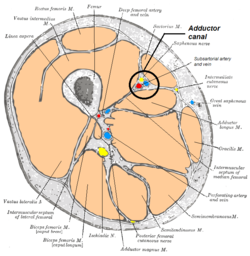Adductor canal
| Adductor canal | |
|---|---|

The femoral artery. (Canal not labeled, but region visible at center right.)
|
|

Cross-section through the middle of the thigh (the right thigh if seen from below)
|
|
| Details | |
| Identifiers | |
| Latin | Canalis adductorius |
| TA | A04.7.03.006 |
| FMA | 58781 |
|
Anatomical terminology
[]
|
|
The adductor canal (subsartorial or Hunter’s canal) is an aponeurotic tunnel in the middle third of the thigh, extending from the apex of the femoral triangle to the opening in the adductor magnus, the adductor hiatus.
It courses between the anterior compartment of thigh and the medial compartment of thigh, and has the following boundaries:
It is covered in by a strong aponeurosis which extends from the vastus medialis, across the femoral vessels to the adductor longus and magnus.
The canal contains the femoral artery, femoral vein, and branches of the femoral nerve (specifically, the saphenous nerve, and the nerve to the vastus medialis). The femoral artery with its vein and the saphenous nerve enter this canal through the superior foramen. Then, the saphenous nerve and artery and vein of genus descendens exit through the anterior foramen, piercing the vastoadductor intermuscular septum. Finally, the femoral artery and vein exit via the inferior foramen (usually called the hiatus) through the inferior space between the oblique and medial heads of adductor magnus.
The eponym 'Hunter’s canal' is named for John Hunter.
Adductor canal
Adductor canal
This article incorporates text in the public domain from the 20th edition of Gray's Anatomy (1918)
...
Wikipedia
